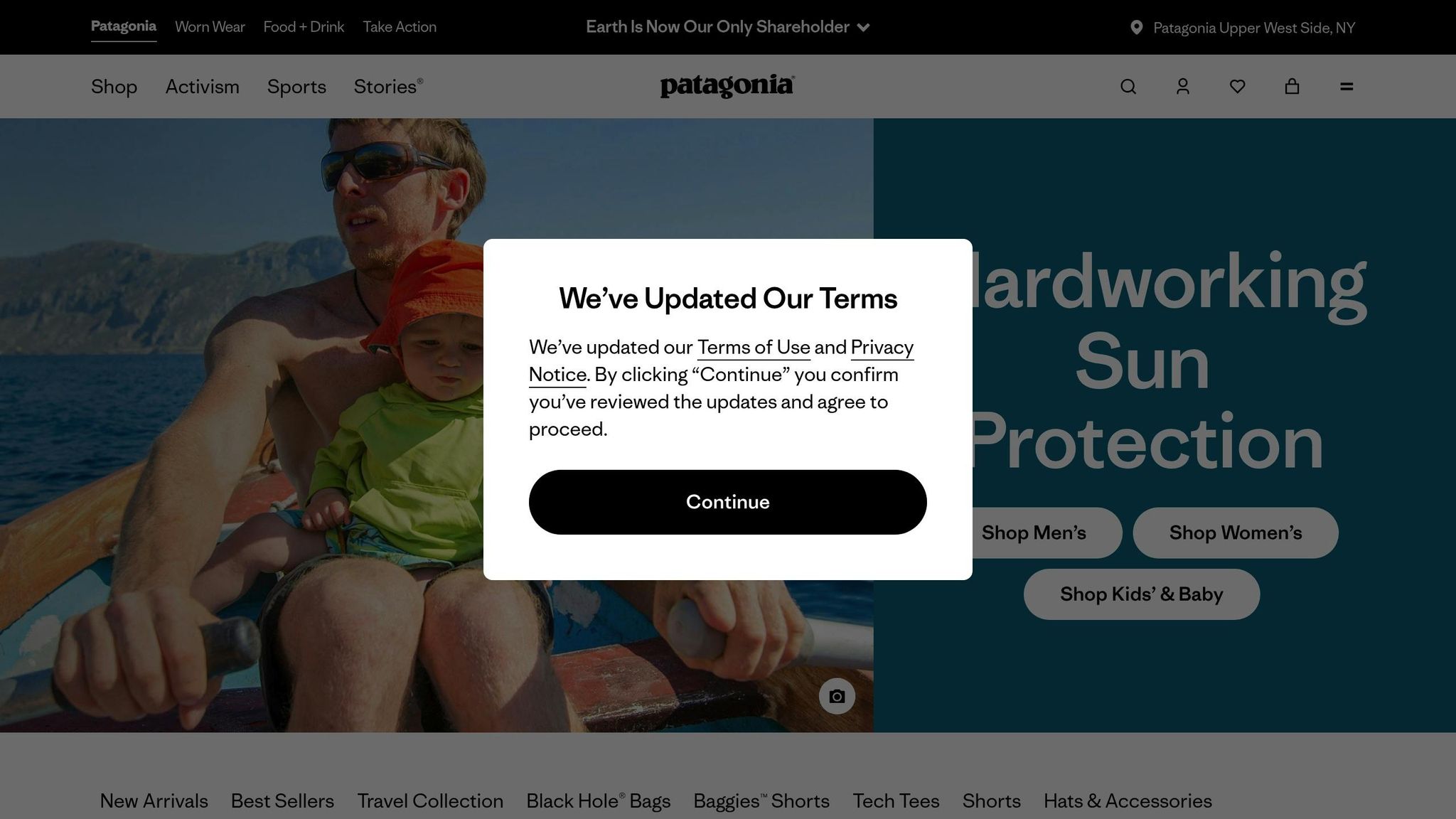Aligning your brand's story, values, and messaging is critical for creating a strong connection with your audience. Why does this matter? Because 82% of shoppers prefer brands that align with their values, and emotionally connected customers spend 300% more. Effective brand positioning builds trust, sets you apart, and drives growth.
Here are four key strategies successful brands use:
- Emotional Storytelling: Brands like Nike and Coca-Cola use compelling stories to inspire and connect with their audience emotionally.
- Shared Values: Companies like Patagonia and Ben & Jerry’s align with customer beliefs, boosting loyalty and revenue.
- Customer Needs: Brands like Amazon succeed by addressing specific pain points with tailored solutions.
- Product Innovation: Apple and TOMS stand out by delivering unique products that resonate with modern consumer priorities.
Real-world examples show how these strategies drive measurable success. For instance, Coca-Cola’s "Share a Coke" campaign reversed declining sales, while Nike’s "Dream Crazy" campaign added $6 billion to its brand value.
Want to refine your brand positioning? Consulting services offer data-driven insights and proven tactics to help businesses achieve alignment and stand out in competitive markets. These strategies aren’t just effective - they’re essential for building lasting customer relationships and driving growth.
7 Brand Strategy Examples (To Position Your Brand)
Core Strategies for Brand Positioning Alignment
Achieving effective brand positioning involves intentional strategies that connect your brand's essence with the values and expectations of your audience. Below, we explore four strategies that have reshaped how brands establish their identity in the marketplace.
Building Emotional Connections Through Stories
Stories have the power to turn a brand into something customers trust and relate to. In fact, 92% of consumers prefer campaigns that feel like a story. This means tapping into your audience's emotions, dreams, and challenges. Take Nike's iconic "Just Do It" campaign, for example. By showcasing athletes overcoming obstacles, Nike not only inspires but also solidifies its image as a symbol of perseverance and achievement. Similarly, Coca-Cola's "Share a Coke" campaign personalized bottles with names and phrases, creating a sense of inclusion and emotional connection. Apple’s "Think Different" campaign celebrated innovators and dreamers, resonating with those who challenge norms and aspire to make a difference. When brands tell authentic, consistent stories that reflect their values and evoke positive emotions, they build stronger bonds with their audience. Aligning these stories with shared values takes this connection even further.
Positioning Based on Shared Values
Modern consumers are driven by beliefs. Sixty-four percent of them expect brands to address societal issues alongside providing quality products. Millennials and Gen Z, who now make up 75% of buying teams, view brands as extensions of their personal values. Brands like Patagonia and Ben & Jerry’s have mastered this alignment. Patagonia’s commitment to environmental activism and Ben & Jerry’s focus on progressive social causes have not only earned loyalty but also boosted revenue. In fact, aligned brands see 33% higher revenue, and companies with strong alignment experience up to 19% faster growth. Additionally, 83% of customers prefer to buy from brands they trust. To achieve this, brands need to invest in thorough market research to understand their audience’s values, craft messaging that reflects those values, and demonstrate authenticity through meaningful corporate social responsibility efforts. This approach lays the groundwork for addressing customers’ specific needs.
Meeting Specific Customer Needs
Focusing on what your customers need most can set your brand apart. Today, 71% of consumers expect personalized interactions, and 76% feel frustrated when brands fall short in this area. Amazon exemplifies this strategy by prioritizing customer feedback and needs, resulting in high satisfaction and loyalty. To effectively address customer needs, start with in-depth market research to understand the demographic, behavioral, and emotional traits of your target audience. Identify their pain points and use data to uncover what drives their purchasing decisions. Position your brand as the solution they’ve been searching for, and reinforce this through tailored product offerings. Product innovation also plays a key role in this strategy.
Using Product Development to Stand Out
Developing standout products helps reinforce your brand’s position in the market. Apple consistently strengthens its identity by launching innovative, easy-to-use products, while TOMS ties each purchase to a meaningful cause through its donation model. Consumer trends also offer valuable direction - 85% of shoppers have shifted to more sustainable purchases in the past five years, and 68% are willing to pay extra for products that align with these values. Effective product-driven positioning starts with understanding consumer behavior through research and refining product features through testing to ensure they resonate with your audience. This approach demonstrates how product innovation can deepen customer engagement and reinforce your brand narrative.
Case Studies: Brand Positioning Success Stories
These case studies showcase how well-crafted brand positioning strategies can lead to tangible success. By understanding their audiences and staying aligned with their core values, these companies built strong, lasting connections with their customers. Each example highlights a unique path to achieving impressive results.
Coca-Cola: Personalization and Emotional Connections

Coca-Cola transformed soda consumption into an emotional experience, focusing on themes like happiness, connection, and togetherness.
The 2012 "Share a Coke" campaign is a standout example. By replacing its iconic logo with popular names and terms like "Mom", "Dad", and "Friend", Coca-Cola created a personal touch that resonated with consumers. In Australia, over 250 million personalized bottles were sold during the first summer, resulting in a 7% increase in consumption among young adults and an 870% surge in Facebook traffic during the campaign's first six months. In the U.S., the campaign reversed a decade-long sales decline, achieving a 2% increase in sales. Globally, it expanded to over 70 countries, selling more than 150 million personalized bottles.
"Our strategy is to deliver doses of happiness in an unexpected, innovative way to engage not only the people present, but the audience at large."
– Leonardo O'Grady, ASEAN IMC Director, The Coca-Cola Company
Coca-Cola extended this emotional engagement through initiatives like the "Open Happiness" campaign. One memorable activation was the "Happiness Machine", a vending machine that surprised users with playful gifts and interactions on college campuses.
This emotional storytelling approach laid the groundwork for Nike’s motivational brand identity.
Nike: Inspiration Through Athlete Journeys

Nike has built its brand around the idea that everyone has the potential for greatness. By focusing on the challenges and triumphs of athletes, Nike inspires consumers to overcome obstacles and embrace perseverance.
One iconic example is the Michael Jordan "Failure" commercial. In it, Jordan states, "I've failed over and over and over again in my life. And that is why I succeed", illustrating Nike's belief in turning failures into stepping stones.
Another impactful campaign, "Dream Crazy", featured Colin Kaepernick with the bold tagline: "Believe in something. Even if it means sacrificing everything." This campaign not only reinforced Nike's commitment to standing for conviction but also added $6 billion to the brand’s value in the following year, according to Apex Marketing Group.
Nike’s "You Can't Stop Us" ad showcased split-screen visuals connecting athletes across different sports, emphasizing themes of unity and resilience. The ad garnered over 32 million YouTube views within 24 hours, drove a 300% increase in social media engagement, and achieved 85% positive sentiment in social media mentions.
"We wanted to show that even though we're apart, we're still united in our fight and our love for sports."
– Greg Hoffman, Chief Marketing Officer at Nike
While Nike motivates through athletic stories, Patagonia takes a different route by prioritizing environmental responsibility.
Patagonia: Commitment to the Planet and Transparency

Patagonia has positioned itself as a leader in environmental activism, integrating sustainability into its brand identity. The 2011 "Don't Buy This Jacket" campaign urged consumers to rethink their purchasing habits, putting environmental responsibility above profit.
This dedication is evident in Patagonia’s financial contributions, including over $100 million donated to environmental causes since 1985 and an annual commitment of 1% of sales to such initiatives. In 2016, the company made headlines by donating 100% of its Black Friday sales to environmental efforts.
Transparency is another key pillar of Patagonia's strategy. Through initiatives like the "Footprint Chronicles", customers can trace the environmental impact of their purchases, fostering trust and accountability. Patagonia’s achievements include earning B-Corporation certification in 2011 and achieving an impressive B Corp Impact Assessment score of 151.4 - nearly three times the median score for B Corp companies.
Patagonia’s sustainability efforts continue to evolve. By Spring 2025, 98% of its products will use preferred materials, over 90% will be made in Fair Trade Certified factories, and the company has already repurposed more than 1,700 tons of plastic waste from discarded fishing nets since 2020.
"We're in business to save our home planet."
– Patagonia's Mission Statement
With annual revenue reaching $1 billion in 2019 and a valuation of around $3 billion, Patagonia proves that prioritizing the planet can drive both customer loyalty and financial success.
sbb-itb-97f6a47
Brand Positioning Strategy Comparison
Each brand positioning strategy is tailored to meet specific market demands, offering distinct advantages and challenges. Here’s a breakdown of key strategies, their benefits, and potential hurdles.
Emotional storytelling taps into feelings and aspirations, forging strong connections with customers. A classic example is Nike's "Just Do It" campaign, which ties the brand to inspiration and achievement [20]. While this approach builds deep loyalty, maintaining authenticity requires consistent messaging across all platforms.
Value-based positioning appeals to budget-conscious consumers by highlighting the value they get for their money. IKEA embodies this with its "Creating a better daily life for many people" philosophy, providing stylish, functional furniture at affordable prices [20]. However, this strategy can limit opportunities for charging premium prices.
Customer need-focused strategies address specific problems head-on. Slack’s "Where work happens" positioning is a prime example, tackling workplace communication challenges [20]. While effective, this approach often narrows the scope for broader differentiation.
Innovation-focused positioning establishes brands as leaders by offering cutting-edge solutions. Tesla’s focus on sustainable energy and high-performance electric vehicles places it at the forefront of automotive advancements. The downside? Staying credible demands significant investment in research and development.
Strategy Comparison Table
| Strategy Type | Target Audience Characteristics | Benefits | Challenges |
|---|---|---|---|
| Emotional Storytelling | Emotionally engaged consumers | Builds strong loyalty and connections | Requires consistent messaging across channels |
| Value-Based Positioning | Cost-conscious, socially aware buyers | Aligns with practical and societal values | Limits potential for premium pricing |
| Needs-Based Solutions | Practical, problem-focused customers | Solves specific issues directly | Narrow scope for broader brand differentiation |
| Innovation-Focused | Tech-savvy, forward-thinking audience | Positions brands as industry leaders | High R&D costs and pressure to innovate |
The success of any strategy depends on market conditions and customer expectations. For instance, 90% of consumers now expect brands to support social and environmental causes, making value-driven positioning increasingly relevant across industries.
"Consumers want to know what your brand stands for... Telling consumers your brand values and communicating them through everything from the name and logo to colors and packaging or online branding all contribute to creating a brand position that consumers gravitate to, and customers stick with."
- Anat Baron, founder of Stashwall [20]
Successful brands often combine elements from multiple strategies for maximum impact. Apple, for example, leverages innovation-focused positioning through its exceptional product design. Patagonia blends value-based positioning with a strong focus on environmental and social responsibility.
Understanding your audience’s motivations is key. Emotional storytelling works best when customers make decisions based on identity and feelings. Value-based strategies resonate with buyers who weigh cost against benefits, while needs-based approaches shine in markets that demand clear problem-solving.
"A brand is just another way of saying you want to connect emotionally with your buyers, your partners, and your customers... Sharing stories that embody your brand's values and mission, such as customer testimonials, behind-the-scenes looks at your product creation, or your brand's journey, make your brand memorable and can convey your positioning in a relatable way."
- Cari Jaquet, Chief Marketing Officer at Normalyze [20]
Market dynamics also play a role in strategy selection. In saturated markets, emotional differentiation can set a brand apart, while emerging markets may favor needs-based solutions. Premium segments often align with innovation, whereas mass markets tend to gravitate toward value-driven propositions.
Using Consulting Services for Brand Positioning
Positioning a brand effectively demands a mix of specialized expertise and an unbiased perspective. Consulting firms bring this combination to the table, offering in-depth knowledge and tested strategies to help businesses carve out a distinct market position that resonates with customer expectations.
One of the biggest advantages of hiring consultants is their objective viewpoint. Unlike internal teams that may be influenced by emotional ties or internal politics, consultants approach brand positioning with a clear, data-driven mindset. They analyze market trends, evaluate competitor strategies, and assess customer preferences without bias, ensuring decisions are grounded in reality rather than assumptions.
The process usually begins with research tailored to the business's needs. Consultants often conduct surveys and focus groups to uncover what the target audience values, what they find frustrating, and what solutions they’re seeking. They also dive into competitive analysis to spot untapped opportunities or areas where the company can stand out.
Take, for example, a mid-sized medical device company that sought help to revamp its brand. By working with brand strategy consultants, the company discovered through research with healthcare professionals that their materials came across as overly formal and failed to highlight real-world benefits. Acting on these insights, the consultants led a rebranding effort that included showcasing patient success stories, simplifying product brochures, and introducing a fresh color palette suited to the medical field. Within a year, the company reported more leads at trade shows, and clients noted that the updated branding made marketing campaigns easier to execute.
Consultants also help businesses sidestep common pitfalls like inconsistent messaging, ignoring customer input, or underestimating competitors. By relying on hard data instead of gut instincts, they minimize the risk of costly missteps. This approach often leads to noticeable improvements in business performance.
The impact of consulting services is quantifiable. Companies that work with marketing consultants report an average 25% boost in return on investment, while customer satisfaction rates rise by 27% for those actively using consultancy services.
"Consultancy positioning is the pivotal act of clarifying the problem(s) your consultancy is solving for a specific audience and how your approach is achieving that." - Luk Smeyers, Founder, TVA
When choosing a consulting partner, business leaders should consider factors like the firm’s industry experience, expertise in project management, compatibility with the company’s culture, and clear project timelines and cost structures.
Finding Experts through the Top Consulting Firms Directory

For businesses looking to refine their brand positioning, the Top Consulting Firms Directory is a valuable tool. It connects companies with experts in areas like digital transformation, revenue growth, and strategic management - key components of effective brand positioning.
The directory’s curated approach helps businesses find firms with proven success in brand strategy. Filters for geographic and industry specialization ensure that consultants understand the market and cultural nuances needed for successful positioning. This is especially helpful for companies expanding internationally, where local insights on marketing themes, regulations, and customs can make or break a campaign.
Digital transformation is a growing challenge in brand positioning, and the directory highlights firms skilled in this area. Companies that embrace digital strategies often see revenue growth rates of 19% - nearly double those that don’t. The directory connects businesses with consultants who excel in leveraging data analytics and multi-channel approaches.
For companies navigating mergers or acquisitions, the platform also identifies consultants experienced in aligning brands during these transitions.
The directory’s focus on measurable results aligns with the consulting industry’s track record. For instance, McKinsey has a 70% success rate in helping clients improve market performance, while Bain helped a retail chain boost customer retention by 40% in two years through targeted strategies. Similarly, Boston Consulting Group has reduced customer churn by 25% in some cases by integrating management insights into marketing efforts.
"Positioning is sharpening the axe. Get it right and your messaging, marketing, hiring and growth become much easier." - Roland Gurney, Agency Marketing Expert
Conclusion
Strong brand positioning is the engine behind measurable growth. Companies that align their brand values with customer expectations see impressive results - 19% faster revenue growth and 15% higher profits. Just look at the success stories of Coca-Cola, Nike, and Patagonia for proof.
Key strategies like building emotional connections, focusing on shared values, addressing customer needs, and driving product innovation resonate because consumers - especially younger ones - are deeply influenced by belief systems. Today’s buyers expect more than just products; they want brands that actively address societal issues alongside delivering quality.
But the impact of alignment goes beyond just the numbers. When customers feel aligned with a brand, they spend twice as much compared to those who don’t share that connection. This kind of loyalty creates a competitive edge that traditional marketing simply can’t replicate.
Sometimes, achieving this level of alignment requires outside help. Brand consulting firms bring an unbiased perspective and the expertise needed to navigate complex markets. They can help businesses avoid common mistakes, like inconsistent messaging, and ensure every customer interaction reinforces the brand’s promise. The case studies highlight how strategic guidance can make all the difference.
For companies ready to elevate their brand positioning, the Top Consulting Firms Directory is a great resource. These experts specialize in areas like strategic management, digital transformation, and revenue growth, offering both the strategic insight and practical execution businesses need to succeed.
In fact, 89% of B2B marketers prioritize brand awareness over direct sales. Companies that invest in aligning their brand positioning don’t just compete - they thrive, creating meaningful connections that fuel long-term success.
FAQs
How can brands use emotional storytelling to build stronger connections with their audience?
Emotional storytelling allows brands to form deeper connections with their audience by drawing on shared values, experiences, and emotions. To make this work, brands should focus on creating genuine narratives that reflect their mission and speak directly to their audience's interests. Including vivid sensory details and relatable characters can make these stories stick in people's minds.
When brands stay true to themselves and address what their audience truly cares about, emotional storytelling can build trust, strengthen loyalty, and inspire meaningful interactions. It’s not just about promoting a product - it’s about forming an emotional bond that keeps customers engaged and returning.
How can a company align its brand with the values of its target audience, and what advantages does this bring?
To connect a brand with the values of its target audience, a company needs to start by truly understanding what drives its customers. This means diving into research and gathering feedback to uncover their core values, preferences, and expectations. Armed with these insights, the brand can then reflect these values in everything it does - its identity, messaging, and interactions - while ensuring consistency across all platforms and customer touchpoints.
When done right, this approach helps build trust, creates emotional connections, and strengthens customer loyalty. The payoff? Tangible results like better retention rates, a growing market share, and increased revenue. Companies that successfully align their brand with their audience’s values often enjoy stronger relationships with their customers and a noticeable edge over competitors.
How can consulting services enhance a company's brand positioning, and what factors should businesses consider when selecting a consulting firm?
Consulting services play a powerful role in refining a company’s brand positioning. They help businesses pinpoint their target audiences, emphasize what sets them apart, and craft strategies that genuinely connect with customers. Beyond that, consultants keep an eye on market trends and monitor critical performance metrics to ensure long-term growth.
When selecting a consulting firm, businesses should focus on a few key factors: deep industry knowledge, a history of proven results, relevant certifications, and a clear alignment with their objectives. Equally important is finding a partner who truly understands your market and can create strategies that fit your specific needs.


